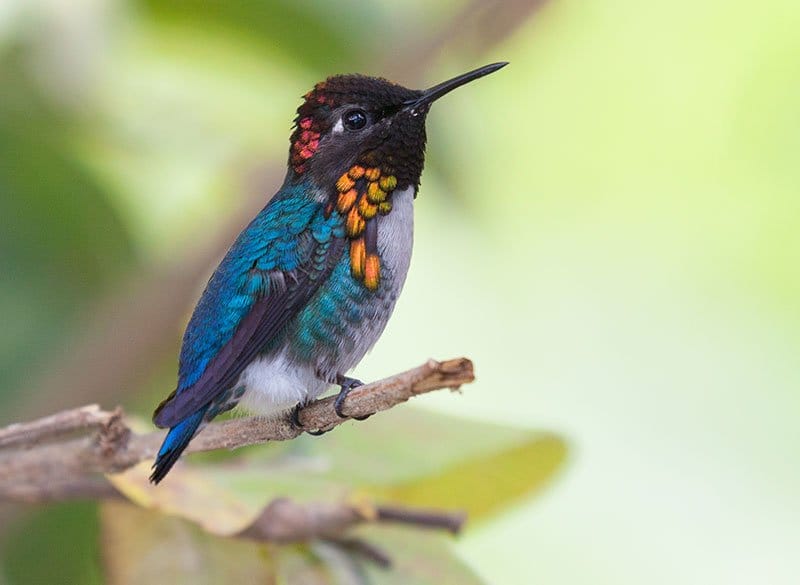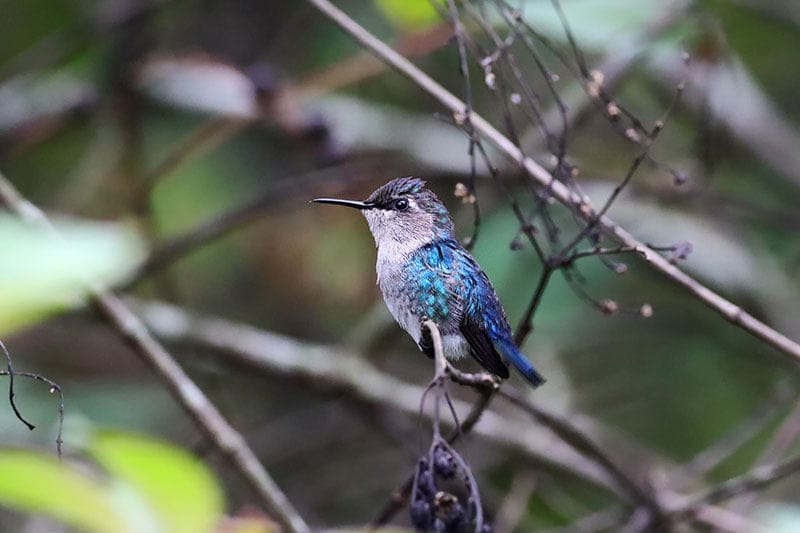Main Menu

The world’s smallest bird is the bee hummingbird (Mellisuga helenae). It is endemic to Cuba, found on the main island and the second-largest Cuban island, Isla de la Juventud (Isle of Youth) in the West Indies. It is one of about 30 birds endemic to the country, which also includes the Cuban parakeet, the Cuban bullfinch, and the Cuban pygmy owl.
Sometimes mistaken for a bumblebee, females measure about 61 mm from beak to tail and weigh 2.6 g while the slightly smaller male has an average length of 55 mm and weighs 1.95 g. This is believed to be the lowest weight limit for any warm-blooded animal.
Bee hummingbirds have straight, short beaks, and rounded tails, narrow wings, and compared to other hummingbirds, which tend to be fairly elongated, are plumper and more rounded.
Males have metallic blue-green upperparts with dark flight feathers and rectrices. The underparts are pale grey with blue and green upper flanks.
On the head, the crown, face, nape, chin, and gorget on the throat are bright iridescent red which may appear anything from dark pink to orange depending on the light. The ear coverts are grey and there are flared feathers on the throat which extend to the sides of the neck in the breeding season.
The bill is black, the eyes are dark brown with black lores, and the legs and feet are black.
Out of breeding season, the male loses the red colour on its head, and it gains blue spots on the tips of the wings, and black tips on the rectrices.
Female bee hummingbirds have iridescent green upperparts and pale grey underparts. There are white tips on the outer rectrices that distinguish it from the non-breeding male.
On the head the crown and nape are green, the face and ear coverts are white, and the lores are black. There is a small white spot behind the eye.
Juveniles look like adult females, although young males have some pink on the throat.
The bee hummingbird spends more time flying than any other species of bird. It can fly for up to 20 hours without a break and can reach speeds of up to 40 – 50 km/h. This means it can fly faster than a jet relative to its size and can withstand g-forces that would make the average human black out.
Like other species of hummingbirds, it can fly up, down, backwards, and even upside down due to specially adapted flight muscles that make up about a third of its body weight. It also has a shoulder joint that is a ball and socket which allows it to rotate its wings by 180° and perform these incredible manoeuvres.
All hummingbirds beat their wings fast which allow them to remain stationary in the air as they feed, averaging about 50 beats a second. The bee hummingbird flutters at around 80 beats a second, although during dives and the male’s courtship rituals it can reach speeds of 200 beats a second, rivalled only by the ruby-throated hummingbird which has the fastest wingbeats of all birds in the world.

The bee hummingbird’s wings beat so fast that it buzzes just like a bee when it’s flying. It also mimics the erratic flight of a bee making several downward dives with intermittent pauses to distract predators and chase away other hummingbirds and insects, such as bees, wasps, and moths, that come to feed in its territory.
Due to its diminutive size, it is predated upon by a wide range of species including larger birds such as falcons, kestrels, and orioles, we well as mongoose, fish, frogs, and tropical spiders.
The bee hummingbird is also thought to have the second-fastest heartbeat of any animal in the world reaching 1260 beats per minute. To put this in perspective, humans have a heartbeat of anything between 60 and 100 heartbeats per minute, while less active birds such as sparrows have hearts that beat at about 460 beats per minute. Only the Etruscan shrew, the world’s smallest living mammal, has a faster heartbeat, clocking in at 1511 beats per minute. The bee hummingbird is too small for us to be able to hear its heart beating but if we could it would sound like a very high-pitched hum.
Bee hummingbirds breed between March and June. Males are polygynous and may mate with several females. At the beginning of the breeding season, they form leks to attract the attention of a female, singing to it and performing aerial displays by flying up to 40 m in the air before plummeting straight down, pulling up just before impact with the ground. They’ll also fly in zigzag and looping patterns and show off their beautiful feathers in the sunlight.
Once a female bee hummingbird has chosen her mate, she’ll start building her nest in the fork of a tree or a shrub. It is a cup-shaped structure measuring about 20 mm across made from twigs, leaves, and spiders webs and lined with softer plant down. The outside is decorated with lichen and shielded with broad, green leaves.
Contrary to popular belief hummingbirds don’t mate in mid-air. The female perches briefly on a branch which gives just enough time for copulation which is over in a couple of seconds.
After mating, the male is chased away by the female who apparently doesn’t want his gaudy feathers attracting predators to the nest. She lays two tiny white eggs, about the size of a coffee bean, which she incubates alone for around 15 days. Once hatched, she cares for the chicks in the nest for 18-22 days, feeding them regurgitated insects to provide much-needed protein to help them grow. After they have fledged and left the nest to find their own food their mother may continue to feed them for another 25 days. They reach sexual maturity at 1 year and can live up to 7 years in the wild.
Like most hummingbirds, the bee hummingbird’s diet consists primarily of nectar, but they also supplement their diet with insects and spiders. They need to consume the equivalent of half their body weight in food each day to stay alive and spend up to 15 per cent of their time eating, visiting as many as 1,500 flowers a day.
Bee hummingbirds prefer nectar with a sucrose content of 15 to 30 per cent. They hover in front of the flowers while feeding using their long tongue to flick nectar into the beak. When not in use bee hummingbirds wrap their tongue under the jaw then behind and over the skull inside the head.
Bee hummingbirds tend to feed mostly at horizontal flowers such as solandria grand flora, a member of the nightshade family with large, trumpet-shaped flowers, or hamelia patens, commonly known as the firebush, with bright orange tubular flowers. Bee hummingbirds are important for the pollination of a number of plants in Cuba and the flowers of these plants have evolved so that their nectar is only accessible to the species, in an example of coevolution.
At first, it seems to make no sense that bee hummingbirds have evolved to be so tiny. They are at more risk from predators, they get attacked by insects, and they need to expend an awful lot of energy keeping their metabolism going.
But there is another species of hummingbird found in Cuba called the Cuban emerald (Riccordia ricordii) which is almost twice the size of the bee hummingbird and it’s likely that this species arrived on the island first.

All alone, the Cuban emerald carved out a niche as a nectar-feeding pollinator. When the ancestor of the bee hummingbird arrived later, and with a limited food supply, it had to find a way to avoid competing for food with the more established species.
To do this, over time it got smaller and smaller feeding from flowers that the Cuban emerald couldn’t reach until it adapted to be the size of the bee hummingbird we know today. The name of this evolutionary process is called island dwarfism or insular dwarfism and happens not only on islands but also in isolated areas such as mountains and valleys.
Smaller sized animals also have a reproductive advantage as they need shorter gestation periods.
Bee hummingbirds are most common in eastern Cuba and the Zapata Swamp, home to over 175 species of birds. Unfortunately, population numbers are declining due to habitat loss and agricultural practices that have reduced the availability of the plants and flowers it relies on for food. It is classified as Near Threatened on the International Union for Conservation of Nature’s Red List for birds.
One Response
I never knew that this bird existed. I have heard that hummingnirds are small but not about the bee hummingbird. I have also never heard of the words “lores” and “leks”. This was a very interesting and informative article. Thank you very much!